

Chin J Plant Ecol ›› 2025, Vol. 49 ›› Issue (3): 367-378.DOI: 10.17521/cjpe.2024.0170 cstr: 32100.14.cjpe.2024.0170
Special Issue: 海岸带
• Research Articles • Next Articles
LIU Ying-Lin, LI Chun-Ming, WANG Hao, WU Chang-Lu, HE Qiang*( )
)
Received:2024-05-22
Accepted:2024-11-25
Online:2025-03-20
Published:2025-01-02
Supported by:LIU Ying-Lin, LI Chun-Ming, WANG Hao, WU Chang-Lu, HE Qiang. Trophic cascades of waterbirds on benthic microalgal communities in coastal wetlands in the Yangtze estuary[J]. Chin J Plant Ecol, 2025, 49(3): 367-378.
Add to citation manager EndNote|Ris|BibTeX
URL: https://www.plant-ecology.com/EN/10.17521/cjpe.2024.0170
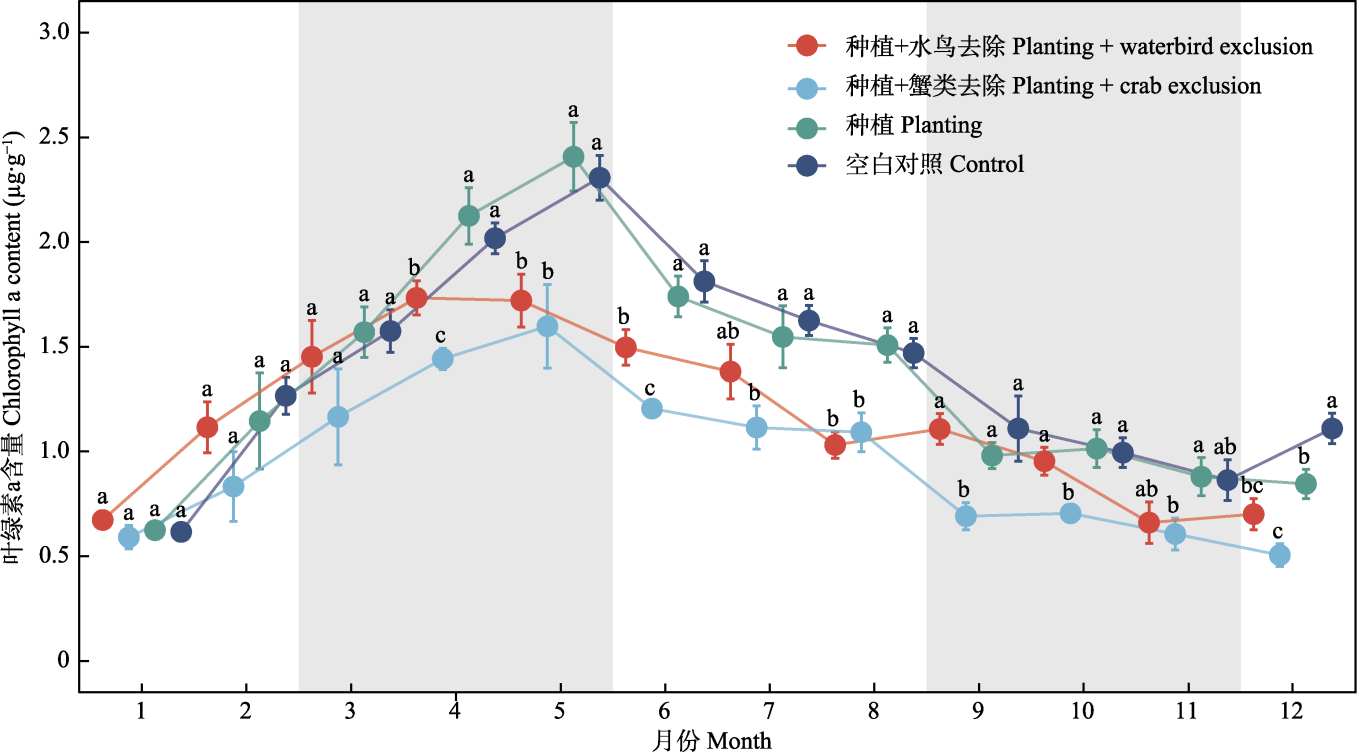
Fig. 1 Biomass (given as chlorophyll a content) of benthic microalgae in different experimental treatments (mean ± SE). Within a month, different lowercase letters indicate statistical differences between different treatments (p < 0.05). Seasons are separated by shadings of different colors.
| 响应变量 Response variable | 种植+水鸟去除 Planting + waterbird exclusion | 种植+蟹类去除 Planting + crab exclusion | 种植 Planting | 空白对照 Control | p (Tr) | p (Ti) | p (Tr × Ti) |
|---|---|---|---|---|---|---|---|
| 水鸟足迹 Waterbird tracks | 3.50 ± 2.17b | 0.17 ± 0.33c | 170.17 ± 45.24a | 165.63 ± 49.42a | <0.000 1 | <0.000 1 | <0.000 1 |
| 蟹洞 Crab burrows | 26.80 ± 2.98a | 0.38 ± 0.32c | 13.54 ± 1.77b | 13.25 ± 1.53b | <0.000 1 | 0.000 3 | 0.220 0 |
| 拟沼螺 Assiminea sp. | 4.92 ± 1.49b | 30.25 ± 6.89a | 2.79 ± 0.82b | 3.50 ± 1.40b | <0.000 1 | 0.008 5 | 0.001 6 |
| 拟蟹守螺 Cerithidea sp. | 3.42 ± 1.21b | 17.54 ± 5.81a | 2.00 ± 0.58b | 2.38 ± 0.83b | <0.000 1 | <0.000 1 | 0.015 6 |
Table 1 Abundances of waterbird tracks, crab burrows, and snails in different experimental treatments (mean ± SE)
| 响应变量 Response variable | 种植+水鸟去除 Planting + waterbird exclusion | 种植+蟹类去除 Planting + crab exclusion | 种植 Planting | 空白对照 Control | p (Tr) | p (Ti) | p (Tr × Ti) |
|---|---|---|---|---|---|---|---|
| 水鸟足迹 Waterbird tracks | 3.50 ± 2.17b | 0.17 ± 0.33c | 170.17 ± 45.24a | 165.63 ± 49.42a | <0.000 1 | <0.000 1 | <0.000 1 |
| 蟹洞 Crab burrows | 26.80 ± 2.98a | 0.38 ± 0.32c | 13.54 ± 1.77b | 13.25 ± 1.53b | <0.000 1 | 0.000 3 | 0.220 0 |
| 拟沼螺 Assiminea sp. | 4.92 ± 1.49b | 30.25 ± 6.89a | 2.79 ± 0.82b | 3.50 ± 1.40b | <0.000 1 | 0.008 5 | 0.001 6 |
| 拟蟹守螺 Cerithidea sp. | 3.42 ± 1.21b | 17.54 ± 5.81a | 2.00 ± 0.58b | 2.38 ± 0.83b | <0.000 1 | <0.000 1 | 0.015 6 |
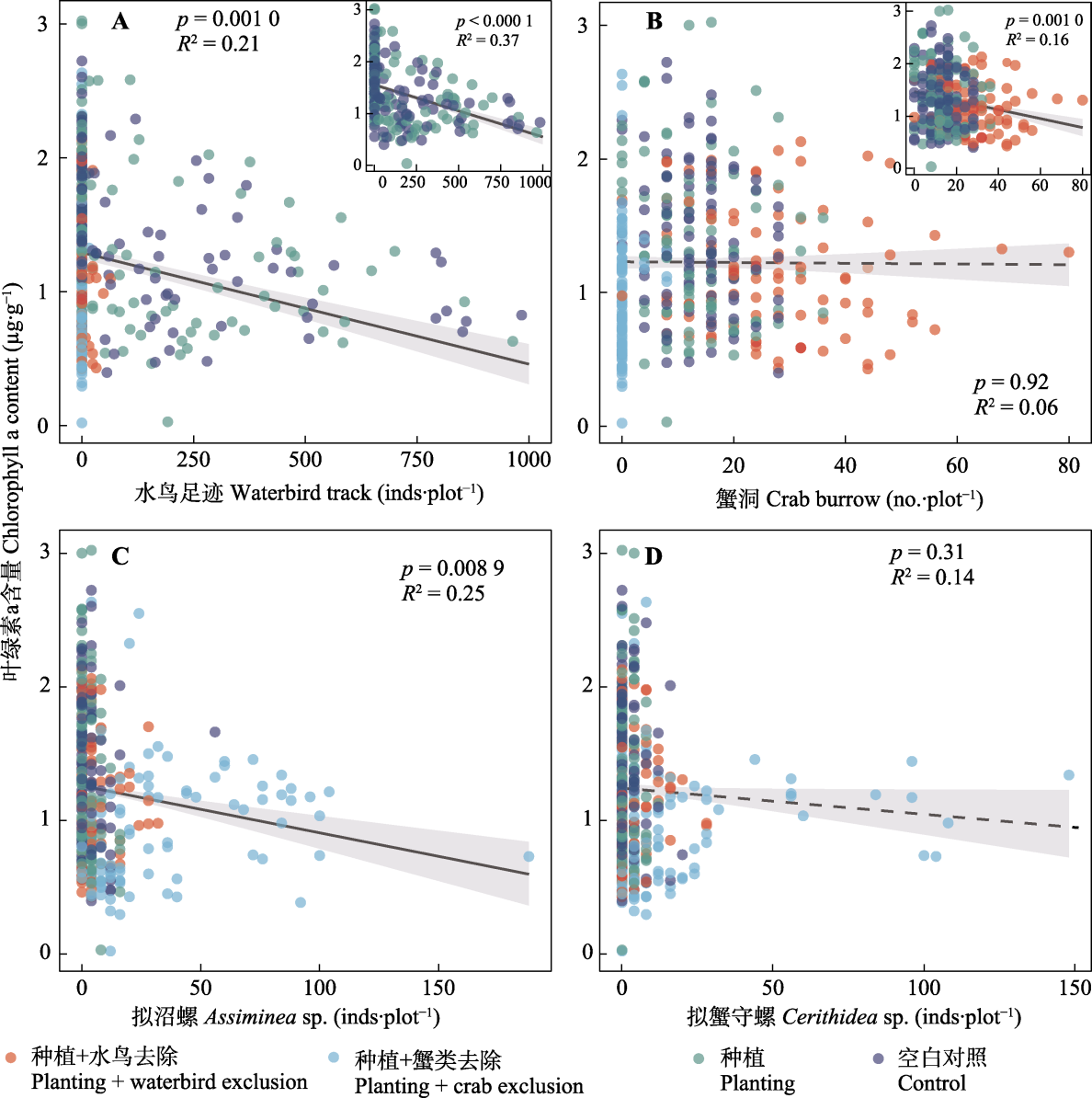
Fig. 2 Relationships between the biomass of benthic microalgae (given as chlorophyll a content) and the abundances of different animal consumers. A, Waterbird tracks (the inset shows the results without planting + waterbird exclusion and planting + crab exclusion treatments). B, Crabs (the inset shows the results without planting + crab exclusion treatments). C, Assiminea sp. D, Cerithidea sp. p indicates the statistical significance of a linear mixed-effects model, and R2 is the proportion of variation in the dependent variable explained by the model, the gray areas are 95% confidence intervals.
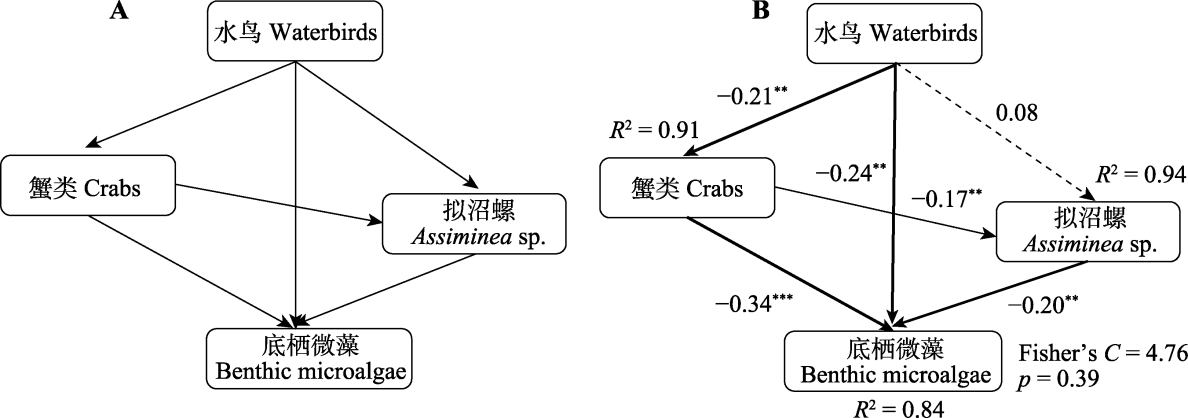
Fig. 3 Structural equation modeling of the effects of waterbirds on the biomass of benthic microalgae. A, Hypothetical model. B, Statistical model. The numbers corresponding to paths are path coefficients; *, p < 0.05; **, p < 0.01; ***, p < 0.001; R2 is the fit of the path.
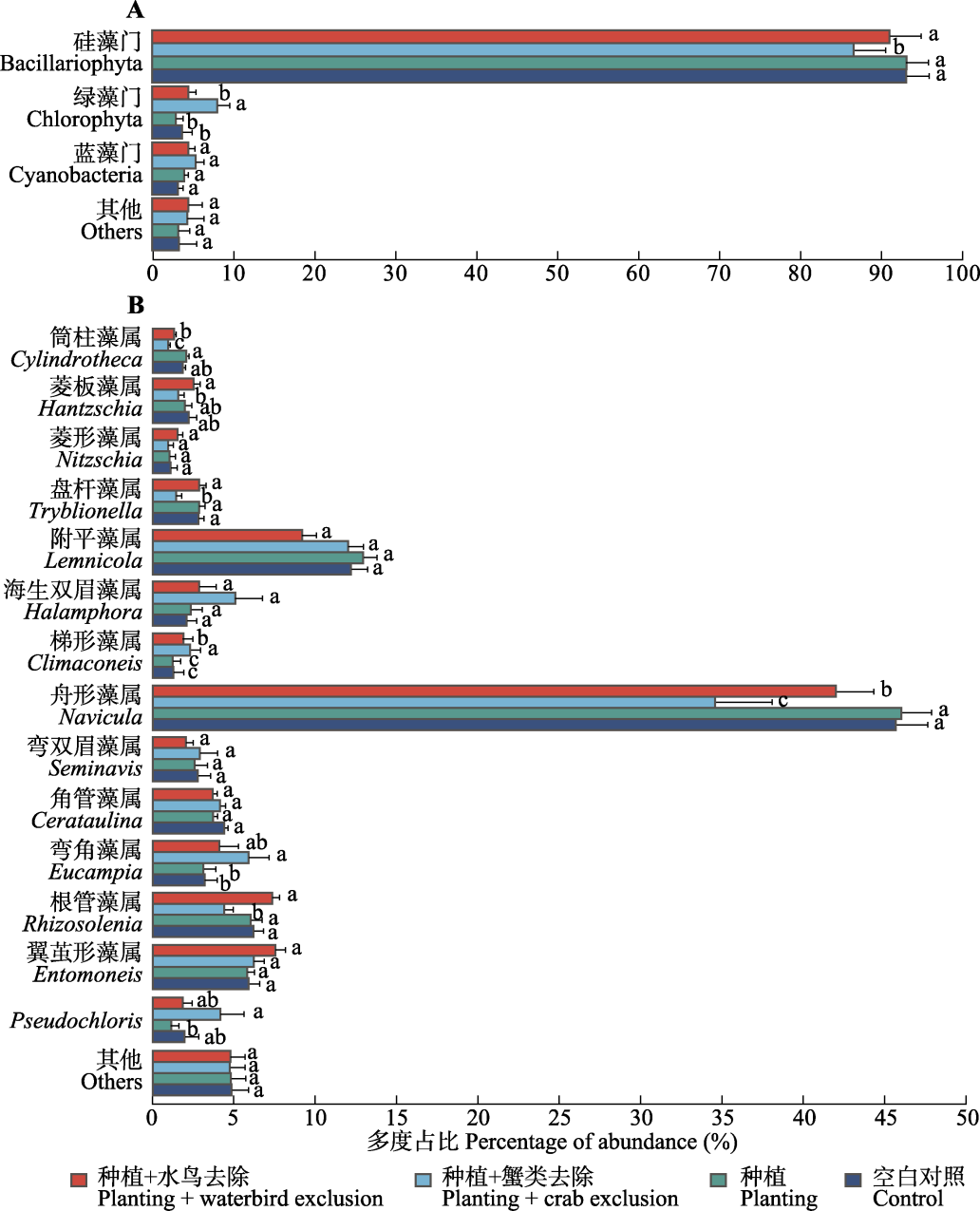
Fig. 4 Differences in the mean relative abundance (%) of benthic microalgae among different experimental treatments (mean ± SE). A, Phylum level. B, Genus level (only for phyla and genera with an abundance percentage greater than 1%; those < 1% are shown as others). Within a phylum or genus, different lowercase letters indicate significant differences between treatments (p < 0.05).
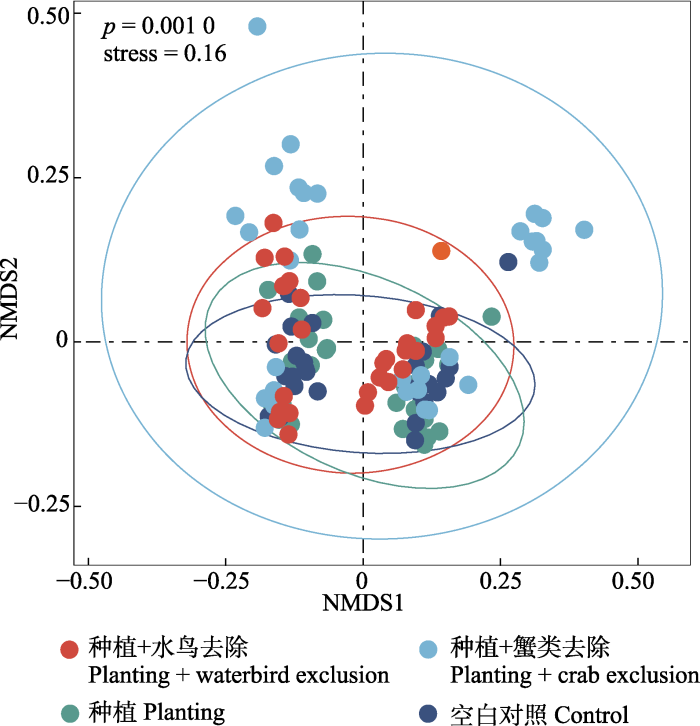
Fig. 5 Non-metric multidimensional scaling (NMDS) analysis for the genus-level composition of benthic microalgal communities in different experimental treatments. Ellipses indicate 95% confidence limit. Stress indicates the difference between the relative distances of samples in the lower-dimensional space and those in the original high-dimensional data; when stress is <0.2, it is generally considered that the model fit is acceptable.
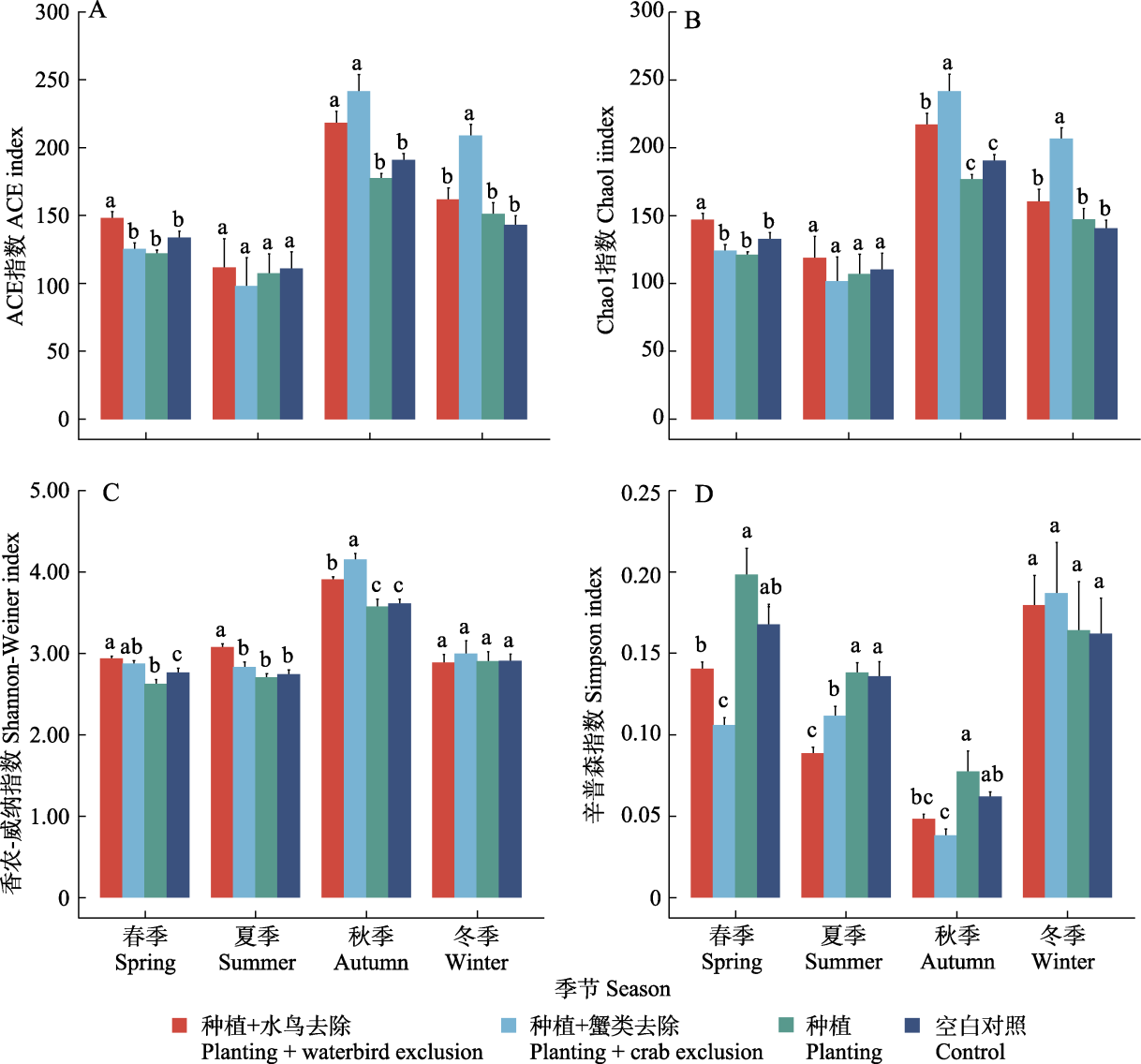
Fig. 6 Diversity indices of benthic microalgae communities in different experimental treatments in different seasons (mean ± SE). Within a season, different lowercase letters indicate significant differences between treatments (p < 0.05).
| [1] | Armitage AR, Fong P (2006). Predation and physical disturbance by crabs reduce the relative impacts of nutrients in a tidal mudflat. Marine Ecology Progress Series, 313, 205-213. |
| [2] | Booty JM, Underwood GJC, Parris A, Davies RG, Tolhurst TJ (2020). Shorebirds affect ecosystem functioning on an intertidal mudflat. Frontiers in Marine Science, 7, 685. DOI: 10.3389/fmars.2020.00685. |
| [3] | Chen JS, Li CM, Wu CL, Sun XN, Feng XS, Zhao JY, Ma ZJ, Wu JH, Bertness MD, Li B, He Q (2023). Top-down control of macrofauna: Are waterbirds passengers or drivers in wetlands? Biological Conservation, 279, 109903. DOI: 10.1016/j.biocon.2023.109903. |
| [4] |
Christianen MJA, Middelburg JJ, Holthuijsen SJ, Jouta J, Compton TJ, van der Heide T, Piersma T, Sinninghe Damsté JS, van der Veer HW, Schouten S, Olff H (2017). Benthic primary producers are key to sustain the Wadden Sea food web: stable carbon isotope analysis at landscape scale. Ecology, 98, 1498-1512.
DOI PMID |
| [5] | Como S, Lefrancois C, Maggi E, Antognarelli F, Dupuy C (2014). Behavioral responses of juvenile golden gray mullet Liza aurata to changes in coastal temperatures and consequences for benthic food resources. Journal of Sea Research, 92, 66-73. |
| [6] | Costanza R, d’Arge R, de Groot R, Farber S, Grasso M, Hannon B, Limburg K, Naeem S, O’Neill RV, Raskin RG, Sutton P, Belt M (1997). The value of the world’s ecosystem services and natural capital. Nature, 387, 253-260. |
| [7] | Heip CHR, Goosen NK, Herman PMJ, Kromkamp J, Middelburg JJ, Soetaert K (1995). Production and consumption of biological particles in temperate tidal estuaries. Oceanography and Marine Biology, 33, 1-149. |
| [8] | Hope JA, Paterson DM, Thrush SF (2020). The role of microphytobenthos in soft-sediment ecological networks and their contribution to the delivery of multiple ecosystem services. Journal of Ecology, 108, 815-830. |
| [9] |
Jia SH, Wang XG, Yuan ZQ, Lin F, Ye J, Hao ZQ, Luskin MS (2018). Global signal of top-down control of terrestrial plant communities by herbivores. Proceedings of the National Academy of Sciences of the United States of America, 115, 6237-6242.
DOI PMID |
| [10] | Jin M, Ye BB, Pang Y, Chu ZS, Yang Q (2016). Study on Margarya melanioides’ feeding characteristics towards four attached algae and its potential restoration in Erhai basin. Acta Ecologica Sinica, 36, 518-524. |
| [靳明, 叶碧碧, 庞燕, 储昭升, 杨琦 (2016). 濒危种螺蛳对4种藻摄食特性及其在洱海流域恢复的可行性探讨. 生态学报, 36, 518-524.] | |
| [11] | Johnson DS, Martínez-Soto KS, Pant M, Wittyngham SS, Goetz EM (2020). The fiddler crab Minuca pugnax (Smith, 1870) (Decapoda: Brachyura: Ocypodidae) reduces saltmarsh algae in its expanded range. Journal of Crustacean Biology, 40, 668-672. |
| [12] |
Kuwae T, Miyoshi E, Hosokawa S, Ichimi K, Hosoya J, Amano T, Moriya T, Kondoh M, Ydenberg RC, Elner RW (2012). Variable and complex food web structures revealed by exploring missing trophic links between birds and biofilm. Ecology Letters, 15, 347-356.
DOI PMID |
| [13] | Li B, Liao CZ, Zhang XD, Chen HL, Wang Q, Chen ZY, Gan XJ, Wu JH, Zhao B, Ma ZJ, Cheng XL, Jiang LF, Chen JK (2009). Spartina alterniflora invasions in the Yangtze River estuary, China: an overview of current status and ecosystem effects. Ecological Engineering, 35, 511-520. |
| [14] |
Li CM, Chen JS, Liao XL, Ramus AP, Angelini C, Liu LL, Silliman BR, Bertness MD, He Q (2023). Shorebirds-driven trophic cascade helps restore coastal wetland multifunctionality. Nature Communications, 14, 8076. DOI: 10.1038/s41467-023-43951-3.
PMID |
| [15] | Longphuirt SN, Lim JH, Leynaert A, Claquin P, Choy EJ, Kang CK, An S (2009). Dissolved inorganic nitrogen uptake by intertidal microphytobenthos: nutrient concentrations, light availability and migration. Marine Ecology Progress Series, 379, 33-44. |
| [16] |
Ma ZJ, Wang Y, Gan XJ, Li B, Cai YT, Chen JK (2009). Waterbird population changes in the wetlands at Chongming Dongtan in the Yangtze River estuary, China. Environmental Management, 43, 1187-1200.
DOI PMID |
| [17] | Miller DC, Geider RJ, MacIntyre HL (1996). Microphytobenthos: the ecological role of the “secret garden” of unvegetated, shallow-water marine habitats. II. role in sediment stability and shallow-water food webs. Estuaries, 19, 202-212. |
| [18] | Ning XR, Liu ZL, Cai YM (1999). Standing crop and productivity of the benthic microflora living on tidal flats of the Xiangshan Bay. Acta Oceanologica Sinica, 21(3), 98-105. |
| [宁修仁, 刘子琳, 蔡昱明 (1999). 象山港潮滩底栖微型藻类现存量和初级生产力. 海洋学报, 21(3), 98-105.] | |
| [19] | Park HJ, Choy EJ, Kang CK (2013). Spatial and temporal variations of microphytobenthos on the common reed Phragmites australis bed in a marine protected area of Yeoja Bay, Korea. Wetlands, 33, 737-745. |
| [20] | Pinckney JL (2018). A mini-review of the contribution of benthic microalgae to the ecology of the continental shelf in the South Atlantic Bight. Estuaries and Coasts, 41, 2070-2078. |
| [21] | Plante CJ, Hill-Spanik K, Cook M, Graham C (2021). Environmental and spatial influences on biogeography and community structure of saltmarsh benthic diatoms. Estuaries and Coasts, 44, 147-161. |
| [22] |
Poore AGB, Campbell AH, Coleman RA, Edgar GJ, Jormalainen V, Reynolds PL, Sotka EE, Stachowicz JJ, Taylor RB, Vanderklift MA, Emmett Duffy J (2012). Global patterns in the impact of marine herbivores on benthic primary producers. Ecology Letters, 15, 912-922.
DOI PMID |
| [23] | Quan WM (2007). Food Web of Analysis of Salt Marshes of the Yangtze River Estuary by Using Stable Isotopes. PhD dissertation, Fudan University, Shanghai. 1-121. |
| [全为民 (2007). 长江口盐沼湿地食物网的初步研究: 稳定同位素分析. 博士学位论文, 复旦大学, 上海. 1-121.] | |
| [24] | Ripple WJ, Estes JA, Schmitz OJ, Constant V, Kaylor MJ, Lenz A, Motley JL, Self KE, Taylor DS, Wolf C (2016). What is a trophic cascade? Trends in Ecology & Evolution, 31, 842-849. |
| [25] | Sawai Y, Horton BP, Kemp AC, Hawkes AD, Nagumo T, Nelson AR (2016). Relationships between diatoms and tidal environments in Oregon and Washington, USA. Diatom Research, 31, 17-38. |
| [26] | Shang X, Guan WB, Zhang J (2009). Distribution characteristics and contribution to total primary production of microphotobenthos in the salt marshes of the Changjiang Estuary. Haiyang Xuebao, 31(5), 40-47. |
| [商栩, 管卫兵, 张经 (2009). 长江口盐沼湿地底栖微藻的分布特征及其对有机质产出的贡献. 海洋学报(中文版), 31(5), 40-47.] | |
| [27] | Shniukova EI, Zolotareva EK (2015). Diatom exopolysaccharides: a review. International Journal on Algae, 17, 50-67. |
| [28] |
Silliman BR, Bertness MD (2002). A trophic cascade regulates salt marsh primary production. Proceedings of the National Academy of Sciences of the United States of America, 99, 10500-10505.
PMID |
| [29] |
Vuppaladadiyam AK, Yao JG, Florin N, George A, Wang XX, Labeeuw L, Jiang YL, Davis RW, Abbas A, Ralph P, Fennell PS, Zhao M (2018). Impact of flue gas compounds on microalgae and mechanisms for carbon assimilation and utilization. ChemSusChem, 11, 334-355.
DOI PMID |
| [30] | Wang SS (2019). The Spatial and Temporal variations of Benthic Diatom Communities in Different Estuarine Mudflats. Master degree dissertation, University of Chinese Academy of Sciences, Beijing. 1-102. |
| [王珊珊 (2019). 河口泥滩底栖硅藻群落结构时空变化特征的比较研究. 硕士学位论文, 中国科学院大学, 北京. 1-102.] | |
| [31] | Wang Y, Liu GZ, Yu GX, Yang XL, Cao LQ, Liu Q (2023). Ecological relationship among mudflat crab (Helice tientsinensis), microphytobenthos and salt marsh plant Suaeda heteroptera inhabiting red beach. Transactions of Oceanology and Limnology, 45, 138-145. |
|
[汪炎, 柳圭泽, 于国欣, 杨晓龙, 曹林泉, 刘青 (2023). 天津厚蟹和红海滩底栖微藻及翅碱蓬的生态关系. 海洋湖沼通报, 45, 138-145.]
DOI |
|
| [32] |
Weerman EJ, Herman PMJ, van de Koppel J (2011). Top-down control inhibits spatial self-organization of a patterned landscape. Ecology, 92, 487-495.
PMID |
| [33] |
Whitcraft CR, Levin LA (2007). Regulation of benthic algal and animal communities by salt marsh plants: impact of shading. Ecology, 88, 904-917.
PMID |
| [34] |
Xu CL, Silliman BR, Chen JS, Li XC, Thomsen MS, Zhang Q, Lee J, Lefcheck JS, Daleo P, Hughes BB, Jones HP, Wang R, Wang SP, Smith CS, Xi XQ, et al.(2023). Herbivory limits success of vegetation restoration globally. Science, 382, 589-594.
DOI PMID |
| [35] | Yan X, Li WJ, Dong H, Zhou X, Zhong KJ, Zhou HK, Ka ZCR, Gu ZH, Jie NDCR, Qi JL, Wu YH, Cai RDZ (2022). Top-down and bottom-up effects on grassland plant productivity and diversity: a review. Journal of Lanzhou University (Natural Sciences), 58, 275-284. |
| [颜熙, 李文金, 董欢, 周喜, 忠克吉, 周华坤, 卡着才让, 顾智辉, 解乃达才让, 祁金兰, 武殷红, 才让东周 (2022). 下行和上行效应对草地植物生产力和多样性影响的研究进展. 兰州大学学报(自然科学版), 58, 275-284.] | |
| [36] | Yoon TH, Kang HE, Kang CK, Lee SH, Ahn DH, Park H, Kim HW (2016). Development of a cost-effective metabarcoding strategy for analysis of the marine phytoplankton community. PeerJ, 4, e2115. DOI: 10.7717/peerj.2115. |
| [37] | Zhang X (2012). Food Sources and Diet Composition of Calidris Shorebirds at Chongming Dongtan. Master degree dissertation, Fudan University, Shanghai. |
| [张璇 (2012). 崇明东滩滨鹬类的食物组成及食物来源. 硕士学位论文, 复旦大学, 上海.] | |
| [38] | Zhang XD (2012). The Effects of Smooth Cordgrass and Crab Bioturbation on Plant Interspecific Relationship and Biogeochemistry in a Salt Marsh in the Yangtze Estuary. PhD dissertation, Fudan University, Shanghai. 1-156. |
| [张骁栋 (2012). 互花米草与蟹类扰动对崇明东滩植物种间关系及生地化循环的影响. 博士学位论文, 复旦大学, 上海. 1-156.] | |
| [39] | Zhang Y, Tong CF (2018). Stomach content characteristics and feeding preference of Chiromantes dehaani in the salt marsh of Yangtze estuary. Chinese Journal of Ecology, 37, 2059-2066. |
| [张元, 童春富 (2018). 长江口盐沼湿地无齿螳臂相手蟹(Chiromantes dehaani)胃含物特征与取食偏好. 生态学杂志, 37, 2059-2066.] |
| [1] | ZHU Wan-Wan, WANG Pan, XU Yi-Xin, LI Chun-Huan, YU Hai-Long, HUANG Ju-Ying. Soil enzyme activities and their influencing factors in a desert steppe of northwestern China under changing precipitation regimes and nitrogen addition [J]. Chin J Plant Ecol, 2021, 45(3): 309-320. |
| [2] | WU Man, LI Juan-Juan, LIU Jin-Ming, REN An-Zhi, GAO Yu-Bao. Effects of Epichloë infection on the diversity and productivity of Achnatherum sibiricum community under various nutrient and mowing conditions [J]. Chin J Plant Ecol, 2019, 43(2): 85-93. |
| [3] | WU Ze-Yan,LIN Wen-Xiong,CHEN Zhi-Fang,FANG Chang-Xun,ZHANG Zhi-Xing,WU Lin-Kun,ZHOU Ming-Ming,CHEN Ting. Variations of soil microbial community diversity along an elevational gradient in mid-subtropical forest [J]. Chin J Plant Ecol, 2013, 37(5): 397-406. |
| [4] | ZOU Yuan-Yuan, LIU Lin, LIU Yang, ZHAO Liang, DENG Qi-Yun, WU Jun, ZHUANG Wen, SONG Wei. Diversity of indigenous bacterial communities in Oryza sativa seeds of different varieties [J]. Chin J Plant Ecol, 2012, 36(8): 880-890. |
| [5] | WU Tong-Gui, WU Ming, LIU Li, XIAO Jiang-Hua. Seasonal variations of leaf nitrogen and phosphorus stoichiometry of three herbaceous species in Hangzhou Bay coastal wetlands, China [J]. Chin J Plant Ecol, 2010, 34(1): 23-28. |
| [6] | ZHANC Feng, ZHANC Jin-Tun, Shangguan Tie-Liang. PLANT DIVERSITY OF FOREST COMMUNITY IN ZHUWEIGOU OF LISHAN MOUNTAIN NATURE RESERVE [J]. Chin J Plan Ecolo, 2002, 26(增刊): 46-51. |
| [7] | JIAN Yong-Xing, LI Ren-Dong, WANG Jian-Bo, CHEN Jia-Kuan. Aquatic Plant Diversity and Remote Sensing of the Beach Vegetation in Lake Poyang [J]. Chin J Plan Ecolo, 2001, 25(5): 581-587. |
| Viewed | ||||||
|
Full text |
|
|||||
|
Abstract |
|
|||||
Copyright © 2022 Chinese Journal of Plant Ecology
Tel: 010-62836134, 62836138, E-mail: apes@ibcas.ac.cn, cjpe@ibcas.ac.cn